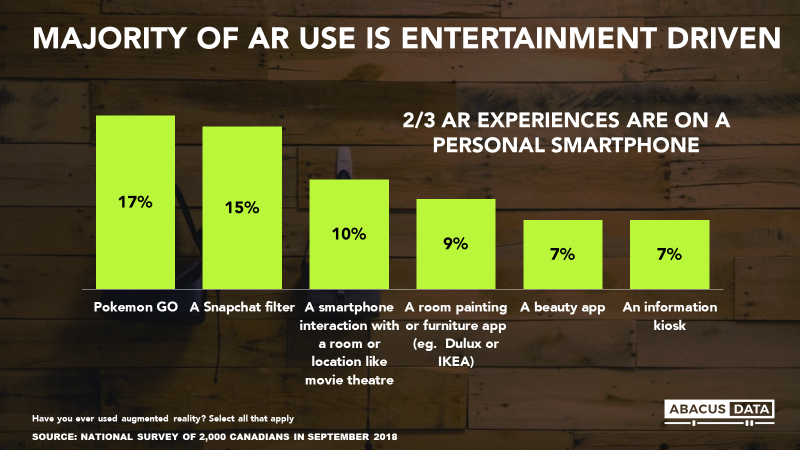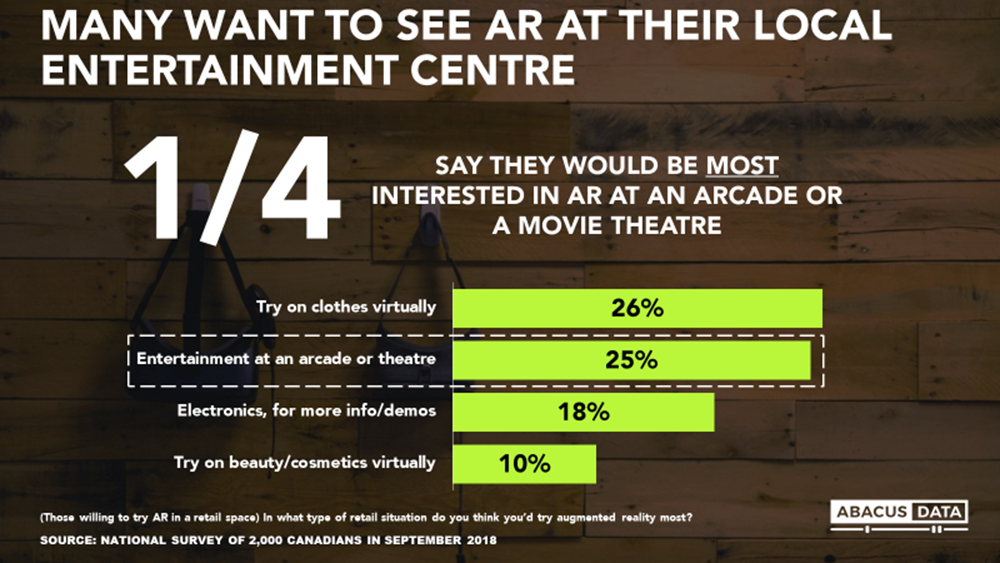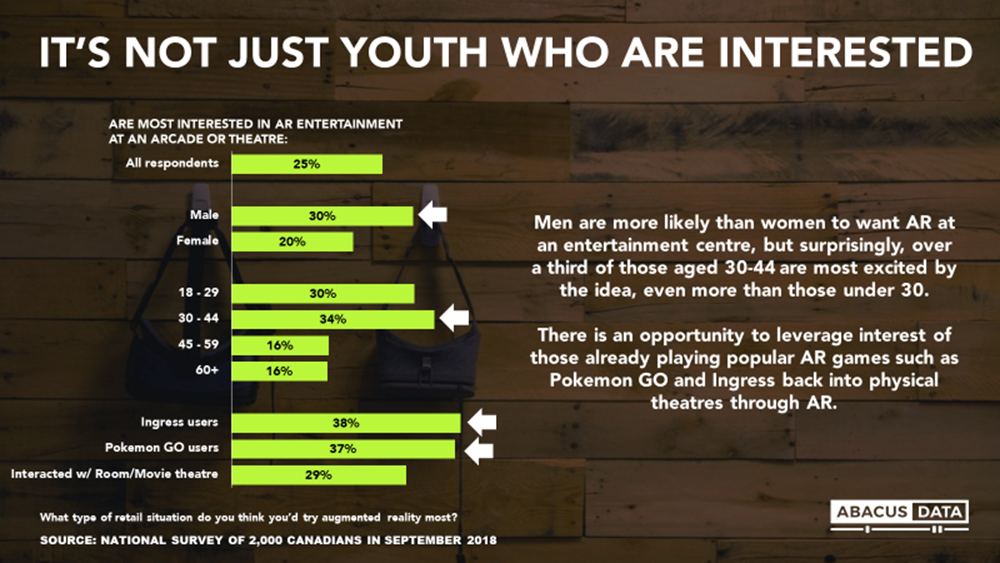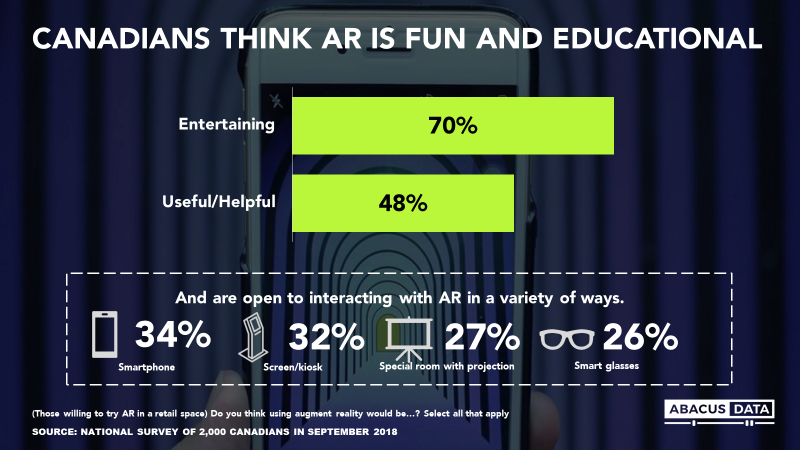Augmented Reality: Gamifying Art and History for the Experience Economy
May 6, 2019
- Part two of a two-part series on Augmented Reality (AR) trends. See part one about AR and retail stores here.
- Augmented reality is transforming how Canadians interact with cultural and entertainment spaces, but these spaces have to go further.
- Over a third of Canadians have already used AR and most are using it for entertainment.
- Many Canadians are hungry for more and more novel ways to explore the technology and are even experimenting with AR on their own.
- Physical spaces of recreation and knowledge such as theatres, galleries, arenas, museums and landmarks are searching for relevancy in a digital world. They have an opportunity with AR to blend their physical environments with digital technology to attract new and younger visitors.
- However, truly implementing AR is not as simple as offering a new exhibit, but also about changing the fundamental nature of these institutions from one-directional communication towards a bi-directional model of audience interaction and involvement.
- It’s time for the gamification of knowledge and information, and AR is the perfect entry point to this model.
AR isn’t confined to culture and entertainment disruption either. See the pdf at the bottom of this page for a short story-deck with some exciting stats and potential applications for different industries, including retail, museums and tourism, and entertainment facilities.
This article only scratches the surface of our study. For a comprehensive deck with an in-depth breakdown of all our findings please email Maciej Czop, Senior Research and Communications Consultant at Abacus Data
The Real-World Versus the Living Room Couch
In an era of intense digital connectivity and stay-at-home entertainment, brick-and-mortar centres of recreation and knowledge such as theatres, galleries, arenas, museums and landmarks are anxious to entice people out of their homes and into the community.
As the world continually splinters into competing distractions and offerings, the marketplace for our attention becomes more heated. More venerable institutions, who traditionally display static exhibits and pieces of significant historical and cultural importance, are especially vulnerable to cultural shifts and waning popularity.
One step towards staving off irrelevance currently being explored is an attempt to leverage augmented reality (AR) to attract visitors. This usually comes in the form of interactive exhibits that engage audiences through both the physical and digital worlds simultaneously.
Although it’s been mostly flying under the radar, AR technology is quickly approaching an inflection point. The latest wave of AR devices on the market point to hardware that is powerful enough, cheap enough, and (maybe most importantly) visually attractive enough to make mass-adoption feasible and leave the industry poised to explode in popularity.

Luckily for proprietors of cultural and entertainment spaces, there’s no need for expensive infrastructure spending or waiting for mass tech-adoption to make overtures into the AR world. The vast majority of Canadians don’t need to spend another dollar on cutting-edge technology to enjoy the engagement afforded by AR, they already carry an AR gateway everywhere they go: Their smartphones.
AR Is Already Here and Its More Popular Than You Think
OK, but this stuff is niche for geeks and kids right? Actually, a massive number of Canadians are already using AR. Just over a third (35%) of all Canadians have used augmented reality, and this number rockets to half (49%) of 30-44-year-olds and almost 7 in 10 (69%) 18-29-year-olds.

AR use seems to be an antithesis to stay-at-home entertainment. It’s being driven by apps and games that get people out of their houses and compel them to interact with their community: 17% of Canadians have used AR through Pokémon GO and 1 in 10 have interacted with AR through a room like a movie theatre.

Museum and tourism AR numbers slightly lag those of purely game-focused AR but are still significant, as 1 in 10 Canadians under 45 have already used AR at an information kiosk.

Many Canadians Are Thirsty for Novel Entertainment
We also asked Canadians what they’d be most interested in using AR for in the future. While the majority of Canadians are most eager about AR benefits in retail and shopping, 1 in 4 are excited about AR as an entertainment option.

It’s not just the amount of people looking for more AR entertainment locations that’s interesting, it’s also the type of people eager to experience these scenarios that raises eyebrows: over 3 in 10 are 30-44 year-olds, even beating out those under 30. Perhaps less surprisingly, men (30%) are significantly more likely to want AR in their theater than women (20%).

Our findings show that those who have already tried AR games such as Pokémon Go and Ingress, another (less popular) location-based mobile game, are the likeliest potential market for AR integration into cultural and entertainment spaces, hinting at a high satisfaction and replay-ability with the technology.

Perhaps most importantly, 7 in 10 Canadians see the value in having AR for entertainment and half of Canadians believe the technology is helpful.

Ready-made Canadian AR Audiences Are Already Available for Cultivation
Despite the rise of high-quality at-home digital entertainment options, many Canadians still desire and pursue more novel experiences. Recently, this has been driving them to explore innovations that combine the digital-world with the real-world. In fact, a third of Canadians are already spending their leisure time experimenting and interacting with their physical environments through AR through personal smartphones.
Our research indicates that attracting those who already use popular AR apps such as Pokémon GO and Ingress is a strategy that should pay off dividends as these Canadians have already bought-into the technology and are actively seeking new ways of experiencing and engaging with it. Partnering with these types of AR apps would allow administrators of physical spaces to access ready-made and motivated audiences and leverage the culture of AR to entice them to visit their physical spaces. This type of partnership may also help circumvent technical challenges that AR implementors face, such as platform integration.
Moving from One-Directional and Static to Interactive and Engaging
AR could be a revolution in helping to attract and engage new visitors to cultural and entertainment spaces, especially piquing the interest of youth to experiment with combining more traditional spaces with novel technology, making the old new again. Sites around the world from MoMA, to the National Gallery of Canada, to the Eiffel Tower have already hosted interactive, augmented-reality exhibits where Instagram-sharing is encouraged.
However, so far overtures into AR have been mostly ad-hoc one-offs, such as special exhibits or temporary events. The traditional experience of one-directional expression by curators and non-participatory consumption by audiences is still very much the norm.
The quest for relevance will likely require spaces to make concerted and systematic efforts, not only to integrate AR throughout a visitor’s experience, but to also change their fundamental nature towards a bi-directional model of audience interaction and involvement.
In other words, institutions cannot rely on just broadcasting the same old information through a new communications channel. They must also experiment with how to leverage the ability of audiences to input and modify their digital environment, to understand things in new ways, and to become active participants in a story. This gamification of knowledge and information is a natural evolution and fit for AR and cultural spaces.
AR isn’t confined to retail disruption either. Here is a short story-deck with some exciting stats and potential applications for different industries, including retail, museums and tourism, and entertainment facilities.
This article only scratches the surface of our study. For a comprehensive deck with an in-depth breakdown of all our findings please email Maciej Czop, Senior Research and Communications Consultant at Abacus Data.
Methodology
The survey was conducted online with 2,000 Canadian residents aged 18 and over from September 15th to 20th, 2018. A random sample of panelists were invited to complete the survey from a set of partner panels based on the Lucid exchange platform. These partners are typically double opt-in survey panels, blended to manage out potential skews in the data from a single source.
The Marketing Research and Intelligence Association policy limits statements about margins of sampling error for most online surveys. The margin of error for a comparable probability-based random sample of the same size is +/- 2.19%, 19 times out of 20.
The data were weighted according to census data to ensure that the sample matched Canada’s population according to age, gender, educational attainment, and region. Totals may not add up to 100 due to rounding.

